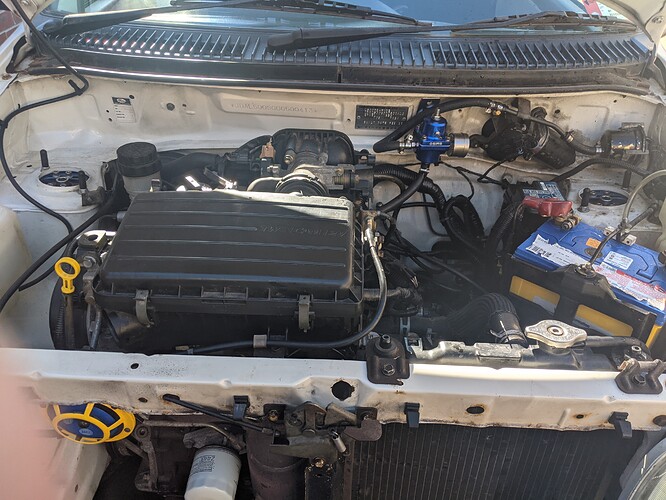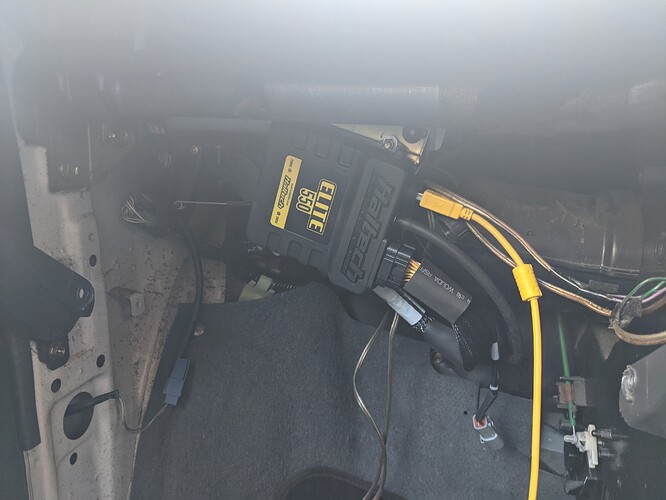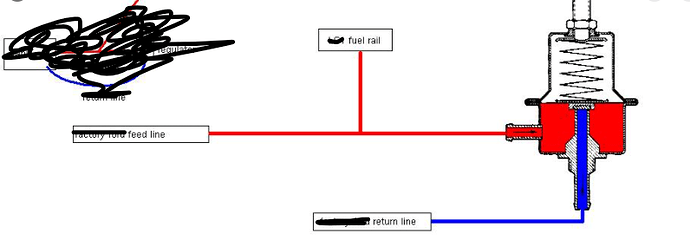Hi everyone, I’m Daryl the father of another member, Mjwalf, I’m a retired mechanic so I have lots of time to work on my sons L500 Mira.
I have installed an engine from a 2005 Charade which as far as I can tell is a EJ-VE, after having problems with the immobiliser a Haltech was purchased and installed, had a bit of a hassle with the trigger settings which Haltech sorted for me.
Got it started this morning, needs be to be tuned but at least it’s running .
Before I can run it for very long I need to flush the cooling system and change the engine oil and filter but I suspect that the radiators hoses are reversed, at the moment the outlet from the thermostat is connected to the bottom hose, on most engines thermostat connects to the top of the radiator.
On some Toyota engines such as a 4AGE the thermostat connects to the bottom of the radiator so my question is which way do the hoses go on a EJ-VE??
Thanks in advance.
Welcome DarylW. I would say you have an ejde as I have only ever seen 1 Australian Delivered L251 charade/mira with an ejve. The difference is the ejve has variable valve timing where the ejde does not. As for the radiator hoses If no one else answer’s I can have a look this arvo for you.
Welcome. Trying to remember off the top of my head - the thermostat at the back of the block goes to the top and the transfer tube on the bottom, which is the bottom radiator. Some more modern engines cool the head/s first which is better for power but harder to get working.
Would be great to see some pics.
Thanks for the replies, I will switch the hoses.
I will post some pics later today.
Is it a VE or DE?
If VE I can’t see any VVT actuator as in the VVT being controlled by the ECU?
Switched hoses and cooling system is bleed and thermostat opened seem good.
BTW the fuel pressure regulator doesn’t have a return port so I bought another one which does.
the easy way with fuel pump regulator is to t piece the inlet to the FPR and the fuel rail. The return goes from the bottom of the FPR to the return to the tank. I have used this method on ejde and the same on turbo ed and efel engine’s with the only difference having to block the stock return and fpr in the fuel rail of ed and efel.
Excellent thanks
easiest way to tell if it is EJ-DE is look for the actuator next to the timing cover, DE will just have a blanking plate thing bolted to it
I have worked on other VVT engines and they usually have a ECU controlled actuator for the VVT but no sign of one on our engine.
As Mark said we assumed it was a VE because that was what was on the donor cars plate.
Also everytime I search for a pic a EJ-VE it looks exactly like our engine, every pic I can find of a DE they look different, its all very confusing.
G’day mate and welcome to the forum.
Very nice job you’re doing there.
As far as VE vs DE, from your photos it is hard to make out whether there is an electronic actuator next to the rocker cover. The main difference with the early and late EJ is the late engine has a different inlet manifold and the rocker cover is integrated into the air box.
If you could get some more photos of the area near the timing cover on the inlet side that would help settle the matter.
Hi, Thanks for the reply, definitely no electronic actuator but the airbox and rocker cover are integrated so looks like its a DE.
It now has a Haltech Elite 550 ECU, after tuning on a dyno it has 57hp at the front wheels and drives very nicely, its a huge power and torque increase over the stock engine, cruises up hills in 4th gear whereas it struggled in 3rd on the same hills with the stock engine.
Its had a leaky brake master cylinder and its been difficult to find a seal kit so car has been off the road, finally found a kit and picking it up tomorrow, we had a spare MC but it was badly corroded, fortunately the MC on the car isn’t corroded so a seal kit should sort it.
how did you sort a trigger wheel setup for it as i am looking at getting a custom 24-1 cam trigger wheel for my EJ when i go to a standalone?
Just used the stock cam trigger, Haltech provided an “experimental” firmware upgrade which allowed the stock trigger to work, put ECU in trigger calibration mode with the timing locked then just had to use a timing light and set the “offset” as per the instructions.
After the engine was dyno tuned the “tune” was sent to Haltech and they were going to include the setup map etc in their next firmware upgrade which will be available to anyone who installs a Haltech.
BTW I highly recommend Haltech, their tech help people are excellent, they even remotely connected to our ECU and sorted a few setup issues.




